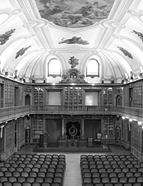

It was in the late 1950s, and especially in the following decade, with the continuation of the 1957 reform, which brought autonomy to the degree in History, multiplied the subjects and reduced the workload attributed to older professors, that the History Cluster began to witness a boost in its teaching staff. This was the result of the recruitment of second assistants, in the areas of Archaeology, Numismatics and Modern History (and for History of Art in 1968, a professor extraordinarius), at the same time as two new medievalists, as mentioned above, completed their doctorates and embarked on their careers, having already taught most of the new entrants.
Father Avelino de Jesus da Costa's dissertation was not innovative in terms of method, but already contained elements that heralded the new historiographical times ahead by including issues related to historical demography linked to desertification, and to economic history in a regional / local space of the Braga diocese at the time of Bishop D. Pedro, but with elements from the 11th to 15th centuries, namely those referring to the censuses.
These subjects would be included in teaching and research from the sixties onwards, and like the earlier examples in Lisbon, with historical demography and quantitative and serial history and their techniques becoming a part of practical classes and students' research, since they were still obliged to write a degree dissertation. These themes were driven by Luís Ferrand de Almeida, who at the time was focusing on the history of techniques, one of the forms of renewing historiography, and especially by myself, at the time more concerned with historical demography and economic and social history, as testified in my doctoral dissertation (2 vols., 1971-1972). It was also the initial period when M. Lopes de Almeida published his collection of documents on the University's arts and crafts, and when Mário Hipólito and Jorge de Alarcão, who had specialised in England, altered the teaching and research of Numismatics, Prehistory and Archaeology, prompting a glorious phase of development for the latter. At the same time, José Sebastião da Silva Dias (1958), who succeeded Joaquim de Carvalho, announced new horizons in the History of Culture which, in France, were reflected in the development of the so-called history of mentalities and structuralism, before the history that was being made was almost turned inside out by post-modernism. Furthermore, Salvador Dias Arnaut, whose great influence was conveyed through the disciples he was able to create, developed and instilled a love for the new local history, also a trigger for historiographical innovations, where his passion for History had begun.
